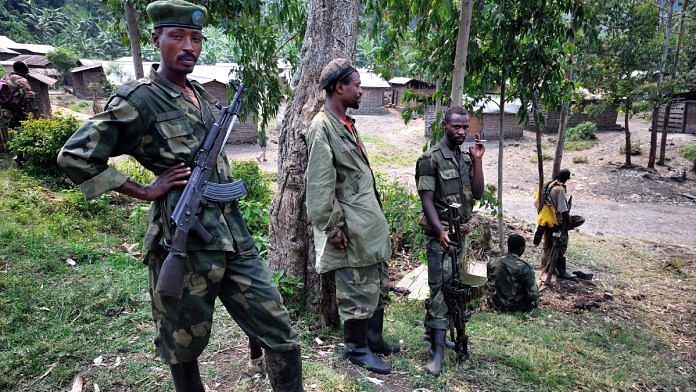New Delhi: Rwanda and the Democratic Republic of the Congo (DRC) have agreed to pursue a “de-escalation process” amid the resurgence of the M23 rebels — an armed group that had been relatively calm since its defeat in 2013.
Named after a failed peace agreement it signed with the Congolese government in 2009, the M23 is dominated by members of an ethnic minority, Congolese Tutsis, many of whom originally immigrated from Rwanda in the 1960s.
It is also known that some of M23’s top commanders once served in the Rwandan Patriotic Front (RPF), which is the ruling party in Rwanda, led by Rwandan President Paul Kagame.
In 2012, armed rebels associated with the M23 captured parts of North Kivu, an eastern province of the DRC. But by 2013, a United Nations-sponsored intervention, aided by Indian peacekeepers, was delivering what many believed was a final blow to the rebel group.
However, M23 reared its head again in late 2021, and has carried out a spate of attacks since March this year.
In late March, eight UN peacekeepers died in a helicopter crash in a part of the eastern DRC where fighting was underway between M23 rebels and the Congolese military. The incident triggered a sharp reaction from the UN and the international community.
The DRC has been blaming the Rwandan government for facilitating the latest M23 insurgency, a charge the latter has denied.
According to the UN, the resurgence of old conflicts is not unique to the DRC but a phenomenon that is also playing out in other African countries, including Burundi, Chad, and Cameroon.
ThePrint explains the events that led to the formation of the M23 rebel group and India’s role in peacekeeping efforts along the Rwanda-DRC border.
Also Read: Cobalt, copper, China: India should pay more attention to the savage violence in Congo
Who are M23 rebels
The M23 traces its roots to the National Congress for the Defence of the People (CNDP), a political militia active in DRC in the 2000s. The CNDP had long been at odds with the Congolese military over the Kivu Conflict, which was the result of a tussle over mineral resources in the eastern DRC province of North Kivu.
After it signed a peace agreement with the DRC government on 23 March 2009, the CNDP became politically active and its soldiers joined the Congolese military. These soldiers came to be known as the M23s, named after the date of the peace agreement.
However, in April 2012, hundreds of these M23 soldiers and CNDP members turned against the DRC government, citing failure to implement the terms of the peace agreement and poor working conditions in the Congolese Army.
Thus began the M23 rebellion, or the March 23 Movement.
In November 2012, the group made headlines around the world when its fighters occupied Goma, the capital of North Kivu, and held on to it for 10 days. This served as a “massive embarrassment” to the UN and the international community, which had invested billions of dollars in peacekeeping efforts in the DRC, according to an article in The Conversation.
Resurgence of M23
According to a report by the Africa Center for Strategic Studies, a US government-funded research institution, M23 managed to seize key parts of the DRC’s Rutshuru territory, bordering Uganda and Rwanda, in March this year.
By May, they had captured a major Congolese military base in North Kivu.
M23 rebels later overran the Rwandan border city of Gisenyi and in June, captured the border city of Bunagana, “forcing Congolese soldiers to flee to Uganda”, added the article.
The M23 has also targeted journalists in the DRC; on 16 June, armed fighters looted a radio station and stole equipment. Veteran journalists in the region claim they have received death threats from M23 rebels who accused them of favouring the Congolese army.
The UN says the rise of these attacks, especially along border areas, is hurting the DRC’s bilateral relations with neighbours such as Rwanda and Uganda.
“Heinous attacks on civilians by armed groups in the Democratic Republic of the Congo are harming bilateral relations between states and contributing to the rise of hate speech,” the world body said in a statement in early June.
India’s role in defeat of M23
The conflict between M23 rebels the Congolese military, aided by UN peacekeepers, has resulted in the deaths of thousands, while displacing millions.
In May this year, ‘Blue Helmet’ peacekeepers from India and other countries received praise from the UN for countering an attack by M23 rebels.
Indian Blue Helmets have been part of the UN’s peacekeeping efforts in DRC since the early 2000s. Tasked with fighting M23 and other armed groups, the peacekeeping force is officially known as the United Nations Organization Stabilization Mission in the Democratic Republic of the Congo (MONUSCO).
In November 2013, M23 was forced to end a 20-month revolt after the Congolese army, aided by UN peacekeepers, captured some of their last strongholds.
In 2016, Rifleman Brijesh Thapa, an Indian peacekeeper who died while serving in Congo, was posthumously awarded the Dag Hammarskjöld Medal — a posthumous award bestowed on military personnel, police, or civilians who lose their lives while serving in the UN peacekeeping force.
The Indian Air Force had set up a contingent (IAC-I), equipped with four Mi-25 attack helicopters and five Mi-17 utility helicopters, in DRC cities, as early as 2003. Years later, the UN approached New Delhi to set up another aviation contingent in the region.
According to reports, as of 2019, about 4,000 Indian army soldiers were part of the UN’s peacekeeping mission in Congo, which has a total of about 20,000 soldiers from around the world.
(Edited by Amrtansh Arora)
Also Read: Modi carried friendship band to Africa, except it is a 10-point guide for mutual engagement






